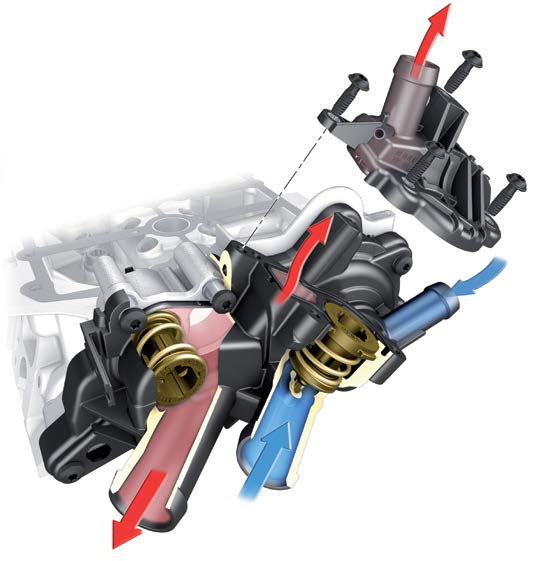
Thermostats have been a crucial component in the internal combustion engines of automobiles for more than a century. Thermostats were incorporated originally for speeding the engine warming-up and reducing cylinder ring wear. At present, these thermostats are playing an increasingly important role in reducing the harmful emissions from the vehicle and increasing engine combustion efficiency. For accomplishing this task, the functions of a thermostat are controlled by the electronic control unit or ECU of the engine, thereby ensuring precise regulation of the engine temperature based on the loads of the engine. Thus, thermostats regulate engine temperature and keep it constant by controlling the flow rate of the coolant through the radiator, thereby making sure that there is a balance between the heat that is introduced into the system and the heat that is released externally.
Advanced technologies are pushing engine combustion quality and efficiency closer to the optimum operating conditions. As the engine is pushed closer to the 230-degree range, desired to improve both fuel economy and emissions, newer thermostat technology is required. Therefore, for raising the operating temperature of the passenger cars constantly to a higher level with safety and optimizing combustion and its accompanying factors the MAP-controlled thermostat was developed. An electrically assisted thermostat of MAP-controlled thermostat offer faster and broader operations as compared to the conventional thermostats. This type of thermostat supplements the basic regulation of the coolant circuit with a wax bulb, functioning as an material for expansion, by means of an electrically integrated and controlled heating element which is activated on demand. The thermostat can consequently influence the temperature considerable swiftly, thus allowing the engine to function in various operating and load conditions within the corresponding optimum range.
Planning to lay down future strategy? Perfect your plan with our report sample here https://www.transparencymarketresearch.com/sample/sample.php?flag=S&rep_id=25556

The global MAP-controlled automotive thermostat market is being strongly driven by the speedy growth of automobile production globally owing to rapid urbanization and rising disposable income in the developing nations. Further, the several benefits offered by these thermostats including offering optimum combustion because of increased component and wall temperatures, reduced fuel consumption owing to reduced frictional loss, lower pollution emissions due to improved combustion and improved power output at full load owing to reduced coolant temperature are expected to boost their adoption, thereby fueling growth of the global market during the forecast period from 2017-2025.
The global MAP-controlled automotive thermostat market can be segmented on the basis of vehicle type into passenger vehicles and commercial vehicles. Passenger vehicles are expected to hold a larger share of the global market during the forecast period, driven by growing urbanization levels and improving road infrastructure coupled with increasing personal mobility requirements and enhanced strength of the middle class segment in emerging nations. The global MAP-controlled automotive thermostat market can be further classified geographically into North America, Europe, Asia Pacific, South America and Middle East and Africa. Asia Pacific is projected to record the fastest growth rate during the forecast period, bolstered by the increasing automotive production in countries such as Japan, India and China and rapidly increasing demand for the mid-segment vehicles.
The global MAP-controlled automotive thermostat market report provides the market share analysis of the key industry participants operating in the industry. The global market comprises a considerable number of manufacturers. These players have been exhaustively profiled and their business overview, financial overview, business strategies and recent developments have been covered under the purview of the report. Some of the major players operating in the global MAP-controlled automotive thermostat market include MAHLE GmbH, Stant Manufacturing, Inc., BorgWarner Inc., Hella KGaA Hueck & Co., Vernet Inc., TAMA Enterprises Co., Ltd., Nippon Thermostat Co., Ltd., Gates Corporation, BG Automotive and MotoRad among others.
The report offers a comprehensive evaluation of the market. It does so via in-depth qualitative insights, historical data, and verifiable projections about market size. The projections featured in the report have been derived using proven research methodologies and assumptions. By doing so, the research report serves as a repository of analysis and information for every facet of the market, including but not limited to: Regional markets, technology, types, and applications.
Looking for exclusive market insights from business experts? Buy Now Report here https://www.transparencymarketresearch.com/checkout.php?rep_id=25556<ype=S
The study is a source of reliable data on:
- Market segments and sub-segments
- Market trends and dynamics
- Supply and demand
- Market size
- Current trends/opportunities/challenges
- Competitive landscape
- Technological breakthroughs
- Value chain and stakeholder analysis
The regional analysis covers:
- North America (U.S. and Canada)
- Latin America (Mexico, Brazil, Peru, Chile, and others)
- Western Europe (Germany, U.K., France, Spain, Italy, Nordic countries, Belgium, Netherlands, and Luxembourg)
- Eastern Europe (Poland and Russia)
- Asia Pacific (China, India, Japan, ASEAN, Australia, and New Zealand)
- Middle East and Africa (GCC, Southern Africa, and North Africa)
The report has been compiled through extensive primary research (through interviews, surveys, and observations of seasoned analysts) and secondary research (which entails reputable paid sources, trade journals, and industry body databases). The report also features a complete qualitative and quantitative assessment by analyzing data gathered from industry analysts and market participants across key points in the industry’s value chain.
A separate analysis of prevailing trends in the parent market, macro- and micro-economic indicators, and regulations and mandates is included under the purview of the study. By doing so, the report projects the attractiveness of each major segment over the forecast period.





